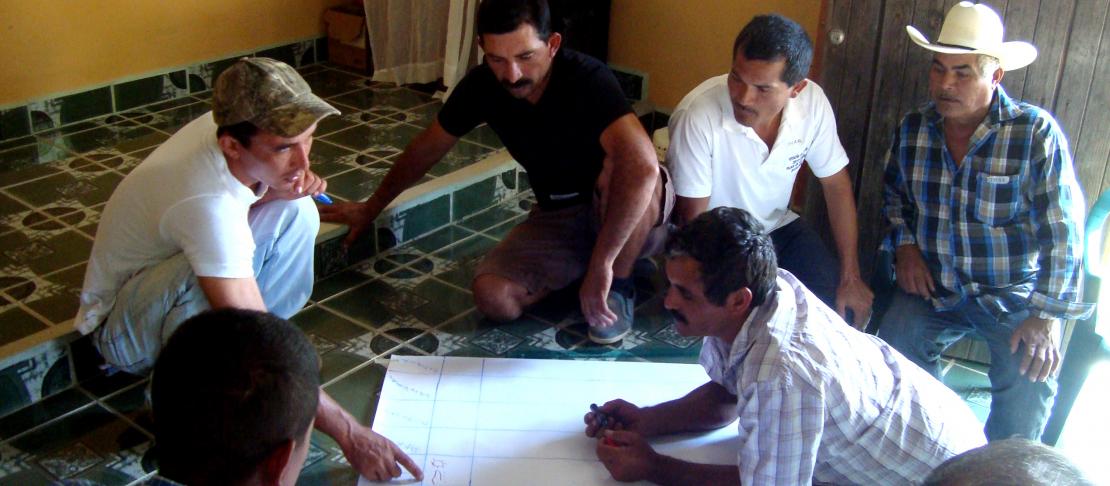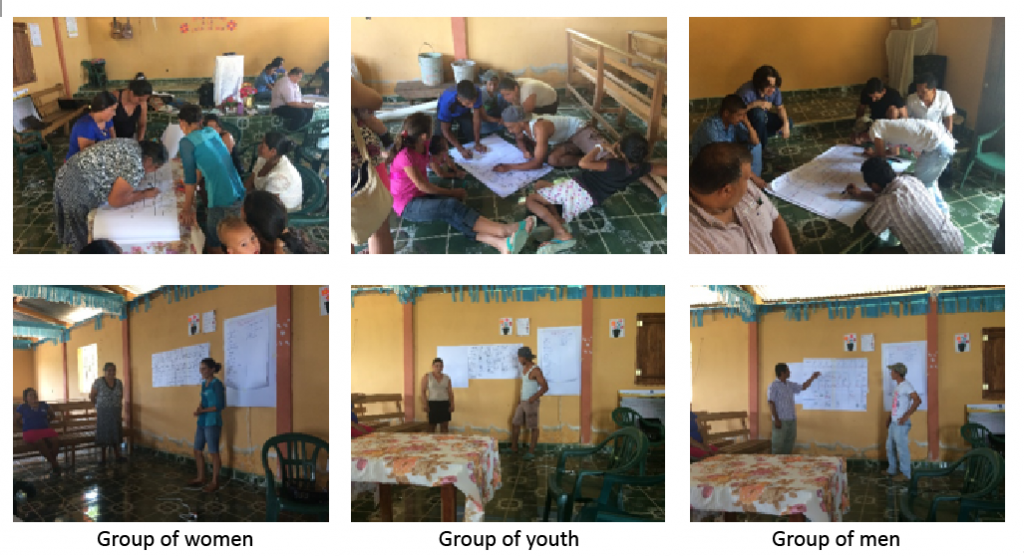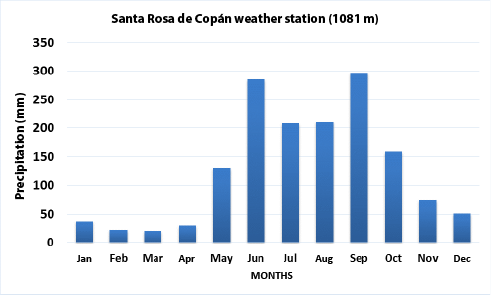Results of the first PICSA workshop with Honduran farmers

More than 40 men, women and young farmers attended the first PICSA workshop to build their capacities to improve household resilience to climate change and variability
In order to help farmers be able to read and understand climate information, CCAFS jointly with CATIE is implementing the "Participatory Integrated Climate Services for Agriculture" (PICSA) approach at Santa Rita Climate-Smart Village (CSV), in Honduras. This activity started with a workshop in the village of Tierra Fría Primera, with the participation of 40 people among men, women and young farmers, plus the researchers from CCAFS and CATIE. Local partners such as Mancomunidad de la Ruta Maya (Mancorsaric) and the regional office of the Ministry of Agriculture and Livestock (SAG) also participated in the journey.
An adjustment to the methodology proposed in the field manual was the use of the home garden and farm plans, which was a contribution of the Mesoamerican Agroenvironmental Program (MAP) of CATIE, replacing the resource allocation map. The seasonal calendar and farmers’ perceptions and historical records were also adressed in the meeting.
The home garden and farm plan is a participatory planning tool of the farm in which the farmers can visualize the current state of their farm, list their resources and the actions to be taken in a given period of time to reach their vision of a "dreamed" farm.
The goal of this exercise was for farmers to think about the current situation of their farms and how they could, based on their own resources, respond to the food demands of their family and at the same time generate surplus to meet other needs, while building capacities to improve household resilience to climate change and variability.

Participatory development of seasonal calendars. Photo: E. Leguia (CCAFS)
In the seasonal calendar, farmers made an array of productive systems of their farms, observed behavior of the rainfalls in the year and activities they perform in each month. The farmers clearly identified the onset of rains, days with extreme heat and the summer season. In the same way, all of them agreed that coffee, corn and beans are the main agricultural crops to which they are devoted during the year. The women pointed out that in certain activities (sowing and harvesting) their participation is restricted to bringing the lunch to the husbands.
The way they perceive the behavior of the rains was confirmed by the presentation of a graph with information from the nearest meteorological station, although the variability or instability of the rainy season is not shown.

Historical precipitation (mm) 1952 - 2013 for the Santa Rosa weather station. Source: COPECO.
The productive cycle in the village begins in April and May, which is when the land is prepared to wait for the first rains that, according to the experience of the producers, begins in June. The perception of all the attendees was that the rains are not the same in start date or quantity in reference to the last years. It is difficult to establish a year or period of comparison, but most of the farmers use as a reference the time in which they worked on their parents' farms. The perception of change in the rains is not recent; it is a process that has been intensifying in the last decades, according to the participants.
In the case of maize, lower precipitation has an immediate impact on grain germination, seedling growth and development. Although beans are a crop that is more tolerant to dry times than maize, lack of rainfall increases susceptibility to pests and diseases, as well as poor grain development. In the case of coffee, the perceived change in rain patterns causes flower abortion and low grain yield, decreasing the quality of the product.
We also made a practical exercise to show what 1mm of precipitation means. The explanation was well received by the farmers, and allowed us to talk about the amount of water required by the crops, which the participants commented on positively because they did not know the water requirements of their crops.
According to Cruz (2013)[1], a tropical variety maize with 120 days of vegetative cycle needs between 600 and 700 mm of water. On the other hand, Salinas (1999)[2], referring to bean production in Nicaragua (Boaco department), mentions that beans require 250 mm of precipitation between germination and harvest period. This exercise of understanding water requirements of crops was key to later explain the behavior of historical precipitation in Santa Rita.
We also shared a graph showing the historical behavior of the rains during the month of June in the last 36 years, noting that, except for the last year, from 2012 to 2015 were years in which the rains were below the normal. Finally, we emphasized the need to keep precipitation records that can help us compare the data obtained in meteorological stations with what actually is raining in each farm.
References
[1] Cruz, O. 2013. Manual para el cultivo de maíz en Honduras. Secretaría de Agricultura y Ganadería, Dirección de Ciencia y tecnología Agropecuaria. Tegucigalpa, Honduras.
[2] Salinas I. 1999, Necesidades Hídricas de los cultivos, Instituto Nicaragüense de Tecnología Agropecuaria INTA, Managua, Nicaragua.
Efraín Leguia is the coordinador of the Climate-Smart Villages of Central America.



